Indian fusion cuisine is a tantalizing blend of traditional Indian flavors with global culinary influences, resulting in an innovative and dynamic culinary experience. This fusion culinary approach seamlessly integrates diverse ingredients, techniques, and cultural inspirations, creating dishes that are both familiar and excitingly unique. From classic Indian dishes infused with international twists to innovative creations that marry Indian spices with global ingredients, Indian fusion cuisine celebrates creativity and diversity on the plate. It invites adventurous palates to embark on a culinary journey where traditional Indian spices harmonize with global tastes, offering a delightful fusion of flavors, textures, and aromas that captivate and inspire.
Chow Mein
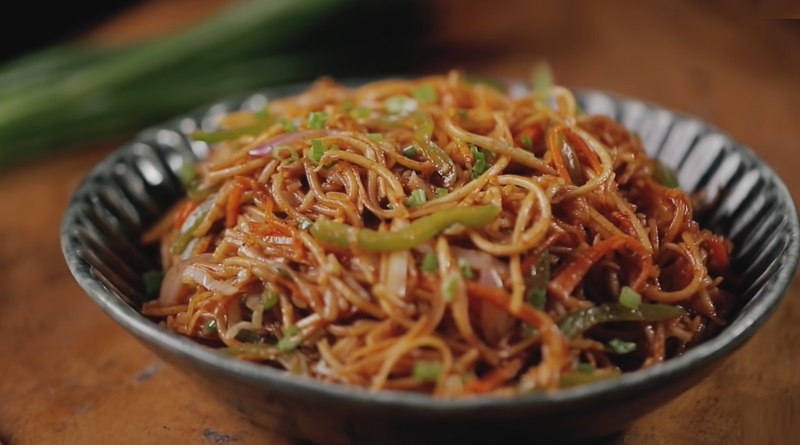
Chow mein is a popular Indian fusion dish that combines the flavors of Indian spices with the textures of Chinese noodles. This dish is a perfect example of the fusion of two distinct culinary traditions to create a unique and delicious meal. The base of chow mein is made with thin noodles that are stir-fried to perfection. These noodles are then combined with a variety of vegetables like bell peppers, carrots, cabbage, and onions, which add color and crunch to the dish. The vegetables are stir-fried with a blend of aromatic Indian spices like cumin, coriander, turmeric, and garam masala, which give the chow mein its distinct Indian flavor. To enhance the taste, some versions of Indian fusion chow mein may also include protein options like chicken, paneer or tofu. These proteins are marinated in a mix of soy sauce, ginger, garlic, and chili paste to add a touch of heat and depth to the dish. The final result is a flavorful and satisfying dish that combines the best of Indian and Chinese cuisines.
Mulligatawny Soup
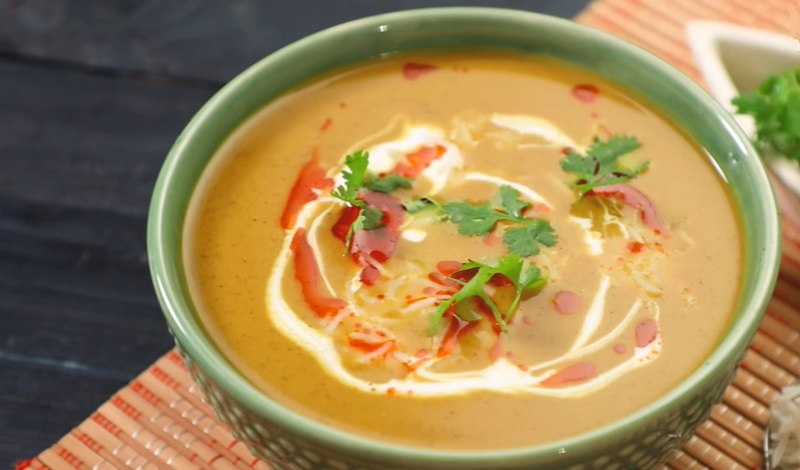
Mulligatawny, a popular Indian fusion dish, is a delicious and aromatic soup that combines the flavors of India with Western influences. The name "Mulligatawny" is derived from the Tamil words "milagu" meaning pepper and "tanni" meaning water, reflecting its rich and spicy nature. Traditionally, Mulligatawny is made with a base of lentils or vegetables, mixed with a variety of spices such as curry powder, turmeric, cumin, and coriander. The soup is then infused with a blend of coconut milk, which adds a creamy and slightly sweet element to the dish. The distinctive taste of Mulligatawny comes from the combination of these spices, creating a balance of flavors that is both bold and comforting. To add a Western twist, Mulligatawny often includes ingredients like chicken, apples, and rice, giving it a unique and diverse flavor profile. The addition of these ingredients enhances the texture and adds a hint of sweetness to the dish. Mulligatawny has become a popular choice for those seeking a fusion of Indian and Western cuisine, as it provides a harmonious blend of flavors that is satisfying and comforting.
Vindaloo
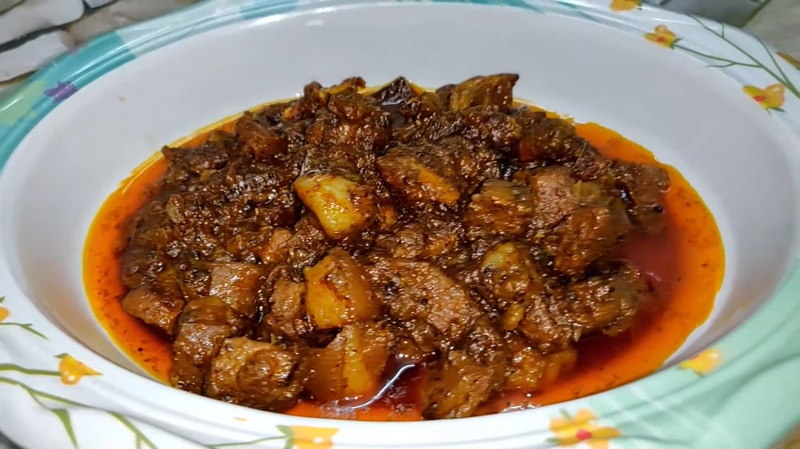
Vindaloo is a popular Indian fusion dish that originated in the region of Goa, a coastal state in Western India. This flavorful and spicy dish is a perfect blend of Indian and Portuguese cuisines, reflecting the historical influence of Portuguese colonization in Goa. The vindaloo usually consists of marinated meat, typically pork or chicken, cooked in a tangy and spicy sauce made with a variety of ingredients. The marinade is prepared by combining vinegar, garlic, ginger, chili peppers, and a mix of aromatic spices such as cumin, coriander, turmeric, and mustard seeds. This mixture is then cooked with the meat, creating a rich and complex flavor profile. What sets Vindaloo apart from other Indian dishes is its fiery and robust taste. The chili peppers and spices give it a spicy kick, while the vinegar adds a tangy and sour note. This combination of flavors creates a unique and mouth-watering experience. Vindaloo is traditionally served with steamed rice or freshly baked bread, such as naan or roti, to balance out the heat and enhance the overall taste. It is a dish that appeals to those who enjoy bold and intense flavors, making it a favorite among spice lovers. Indian fusion cuisine like vindaloo showcases the diverse culinary heritage of India, blending traditional Indian spices and cooking techniques with foreign influences.
Fried Rice
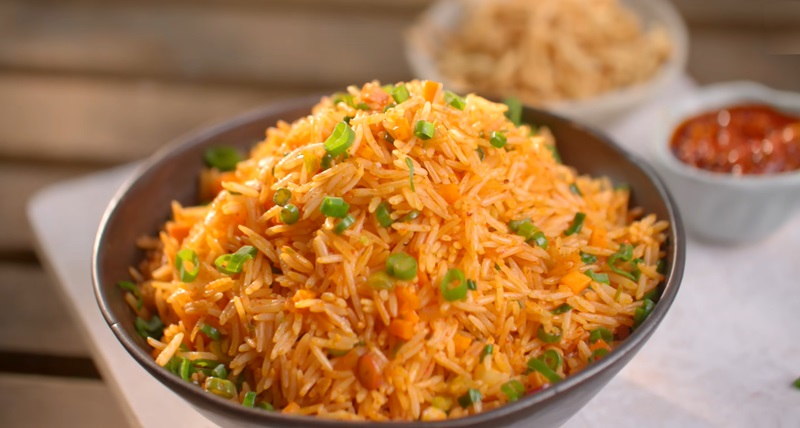
Indian fusion cuisine takes the classic fried rice dish to a whole new level by infusing it with aromatic Indian spices and flavors. This delectable creation combines the best of both worlds, offering a tantalizing and unique culinary experience. The base of the dish remains true to the traditional fried rice, with fluffy grains cooked to perfection. However, what sets Indian fusion fried rice apart is the addition of vibrant and fragrant spices such as cumin, turmeric, and garam masala. These spices not only add a burst of flavor but also lend a beautiful golden hue to the rice. To further enhance the dish, various vegetables and proteins are added. Colorful bell peppers, sweet corn, peas, and carrots provide a refreshing crunch, while succulent pieces of marinated chicken, paneer or tofu add a delightful protein element. The fusion element truly comes alive with the incorporation of Indian condiments and garnishes. Fresh cilantro, and a squeeze of lime juice enhance the overall freshness and tanginess of the dish.
Korma
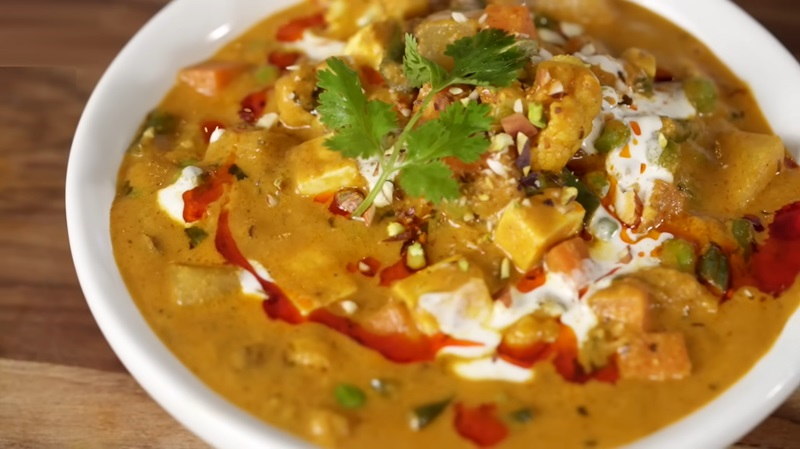
Korma has its origins in the lavish Mughlai cuisine of the Indian subcontinent, dating back to the 16th century when the Mughals expanded into South Asia. A korma is traditionally prepared by slowly cooking meat or vegetables with yogurt or stock, resulting in a culinary masterpiece. There are various styles of korma, each with its own unique combination of flavors. Ground coriander and cumin are skillfully blended with yogurt, added gradually to prevent curdling. This meticulous process typically takes place in a pot over a gentle flame, sometimes with the use of charcoal on the lid for even heat distribution. Korma can be delicately spiced or boldly fiery, and it can be made with lamb, goat, chicken, beef, game, or even a medley of vegetables like spinach and turnip.
Hot and Sour Soup
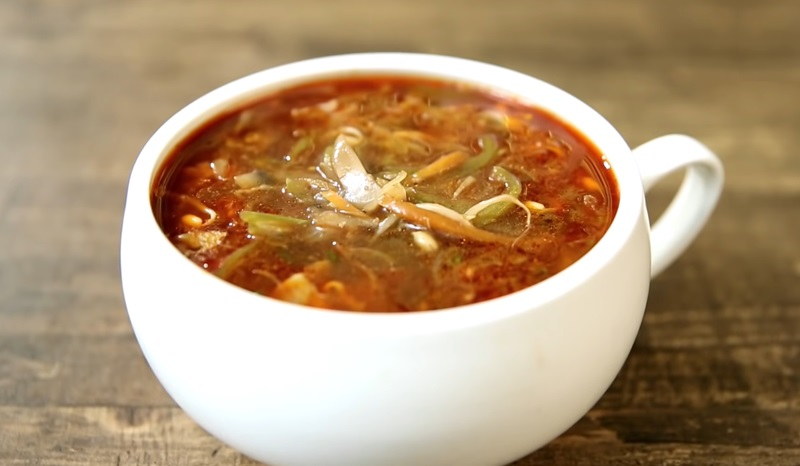
Hot and sour soup is a popular dish in Indian fusion cuisine that combines the flavors of both Indian and Chinese cuisines. This soup is a perfect blend of spicy and tangy flavors, making it a favorite among food enthusiasts. The base of the soup is made with a combination of vegetable or chicken broth, vinegar, and soy sauce, giving it a tangy and savory taste. It is then infused with a variety of ingredients like mushrooms, tofu, carrots, and bamboo shoots, adding a burst of texture and flavor to the dish. To enhance the spiciness, Indian spices like chili powder, ginger, and garlic are added to the soup. These spices not only provide a fiery kick but also contribute to the overall aroma of the dish. Hot and sour soup is served piping hot, garnished with fresh coriander leaves and spring onions.
Manchurian
-1708946445.jpg)
Manchurian is a popular Indian fusion dish that combines Chinese flavors with Indian spices. It is a delectable and unique creation that has become a favorite among food lovers. The dish typically consists of deep-fried vegetable or meatballs, which are then tossed in a tangy and spicy sauce. The balls are made from a mixture of finely chopped vegetables or minced meat, along with breadcrumbs and spices. They are deep-fried until golden brown and crispy. The sauce used in Manchurian is a perfect blend of Indian and Chinese flavors. It is made with a combination of soy sauce, garlic, ginger, green chilies, and various spices. This sauce adds a rich and flavorful element to the dish. Manchurian can be enjoyed as an appetizer or as a main course, served with steamed rice or noodles. The dish offers a delightful balance of textures and flavors, with the crispy balls complemented by the spicy and tangy sauce.
Kedgeree
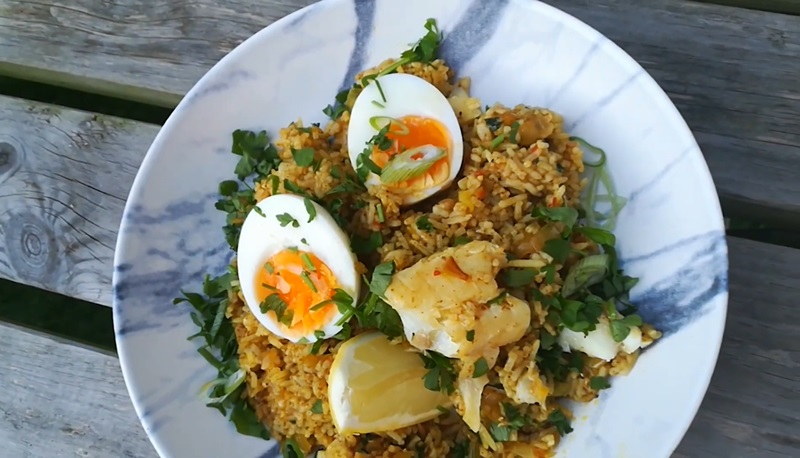
Kedgeree is a delightful dish that showcases the fusion of Indian and British culinary influences. Originating from colonial India, this dish has become a popular breakfast or brunch option in many parts of the world. Kedgeree typically consists of flaked fish, traditionally smoked haddock, mixed with rice, eggs, and an aromatic blend of spices. The process of making kedgeree involves poaching the fish in milk or water, then combining it with boiled rice and gently cooked onions. The dish is further enhanced with the addition of spices like turmeric, cumin, and coriander, which infuse it with a warm and earthy flavor. To add a touch of richness, butter or ghee is often used during the cooking process. Kedgeree is usually garnished with fresh herbs, such as coriander or parsley, and served with wedges of lemon to provide a refreshing zing.
Jalfrezi
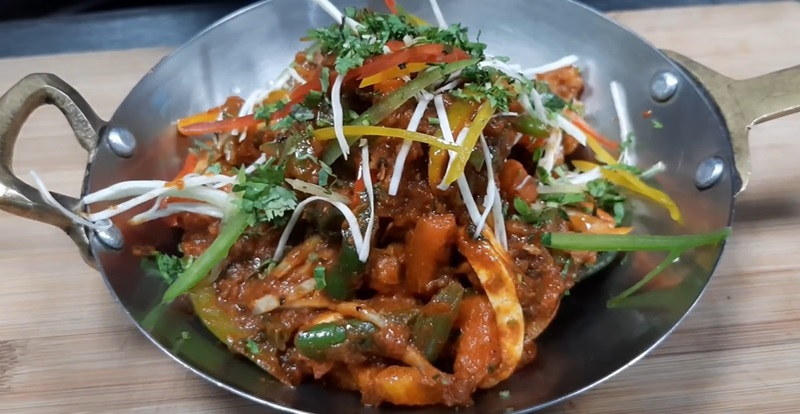
Jalfrezi is a vibrant Indian dish that originated during the British Raj era, stemming from the British fondness for stir-fried leftovers. Its name, derived from the Bengali words "jal" meaning spicy and "frezi" meaning fry, reflects its bold and flavorful nature, blending influences from both Indian and British cuisine. To prepare Jalfrezi, marinated pieces of meat, typically chicken or lamb, are stir-fried with a range of colorful vegetables like bell peppers, onions, and tomatoes. A combination of spices such as cumin, coriander, turmeric, and chili is added to create a robust and aromatic flavor. Some variations may incorporate ginger, garlic, and garam masala for added complexity.
Bebinca
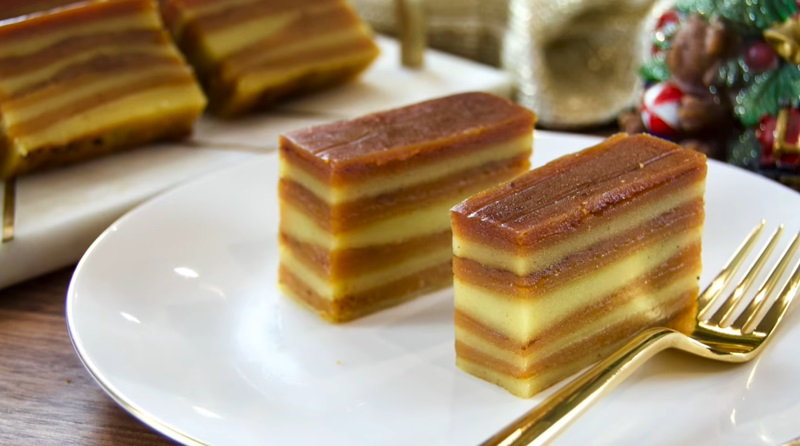
Bebinca is a delectable dessert that is a fusion of Indian and Portuguese cuisine. Originating from Goa, a coastal state in India, Bebinca is a beloved sweet treat that is often prepared during festive occasions and celebrations. This layered dessert is made with a combination of flour, sugar, ghee (clarified butter), coconut milk, and eggs, which are mixed together to form a smooth batter. The batter is then poured into a baking dish, and each layer is cooked until it turns golden brown and slightly crispy. Traditionally, Bebinca consists of seven to sixteen layers, each one adding a unique texture and flavor to the dish. The use of coconut milk in Bebinca gives it a rich and creamy taste, while the ghee adds a buttery and aromatic element. The dish is typically served warm and can be enjoyed on its own or paired with a scoop of ice cream or a dollop of whipped cream. Bebinca beautifully combines the culinary influences of India and Portugal, resulting in a dessert that is unique and luscious.
Manchow Soup
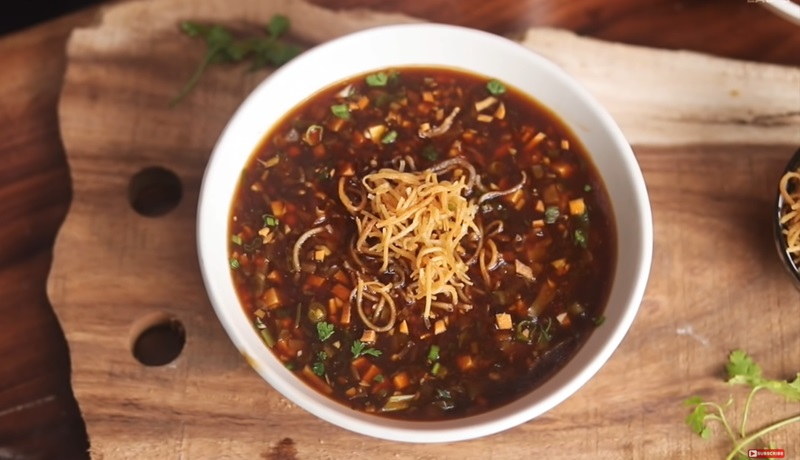
Manchow Soup, a beloved dish in Indian fusion cuisine, marries Chinese and Indian tastes for a distinctive and delightful soup experience. This rich, dark brown soup features an array of vegetables, scallions, and chicken, simmered to perfection with broth and corn flour for thickness. The robust flavor comes from a blend of soy sauce, garlic, chili peppers, and prominently, ginger. Available in both vegetarian and non-vegetarian options, it's finished with a sprinkle of chopped spring onions and accompanied by crispy fried noodles for a satisfying crunch.
Chicken Lollipop
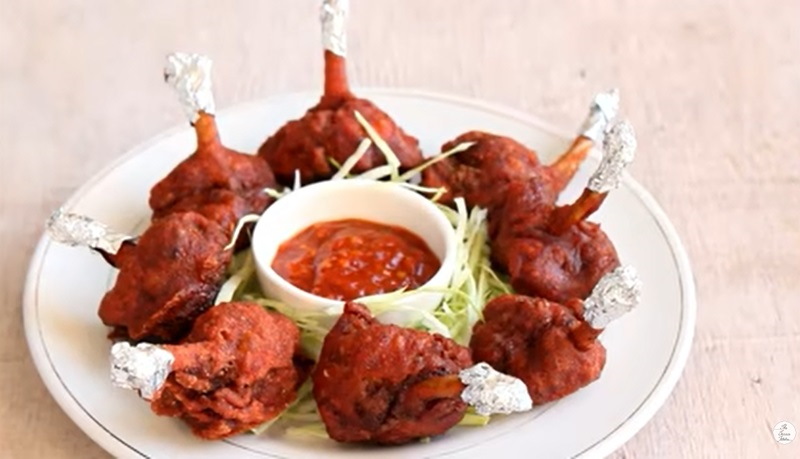
Chicken lollipop is a popular Indian fusion dish that combines the flavors of Chinese and Indian cuisines. This delectable appetizer is made from chicken wings, which are frenched to resemble a lollipop, hence the name. The chicken wings are marinated in a flavorful blend of Indian spices such as ginger, garlic, cumin, coriander, and chili powder, along with a hint of soy sauce to give it a Chinese twist. The marinated chicken wings are then deep-fried until golden brown and crispy. The result is a tantalizing combination of flavors and textures - the juicy and tender chicken meat inside is perfectly complemented by the crispy and slightly spicy outer coating. Chicken lollipops are often served with a tangy and spicy sauce, such as a sweet and sour or chili garlic sauce, for dipping.
Chilli Chicken

Chilli chicken is a popular dish in Indian fusion cuisine that combines the flavors of Chinese and Indian cooking. It is a delectable blend of tender chicken pieces, marinated in a mixture of soy sauce, vinegar, and spices, then stir-fried with onions, bell peppers, and green chilies. The dish is known for its spicy and tangy flavor profile, which is achieved by adding red chili sauce, tomato ketchup, and a dash of lime juice. The chicken is first marinated to enhance its tenderness and to infuse it with the flavors of the marinade. It is then stir-fried on high heat to give it a slightly crispy texture. The addition of onions, bell peppers, and green chilies not only adds color to the dish but also provides a delightful crunch.
Sarapatel
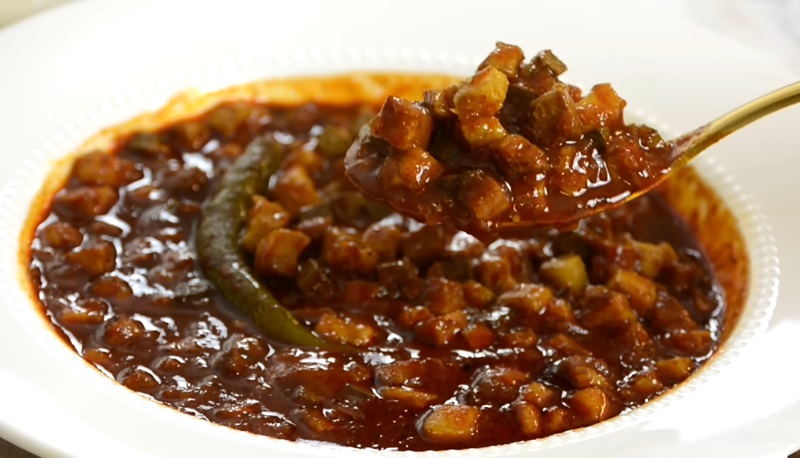
Sarapatel is a delectable Indian fusion dish that combines the flavors of Portuguese and Goan cuisine. Sarapatel is typically made with a combination of pork or offal, such as liver and heart, cooked in a rich and spicy gravy. The dish is characterized by its deep, earthy flavors, which are derived from a blend of spices such as turmeric, cumin, coriander, and red chilies. Additionally, vinegar is added to provide a tangy and slightly sour taste. The dish is traditionally slow-cooked, allowing the flavors to meld together and create a complex taste profile. Sarapatel is often served with steamed rice or crusty bread, which helps to soak up the flavorful gravy.
Major Grey's Chutney
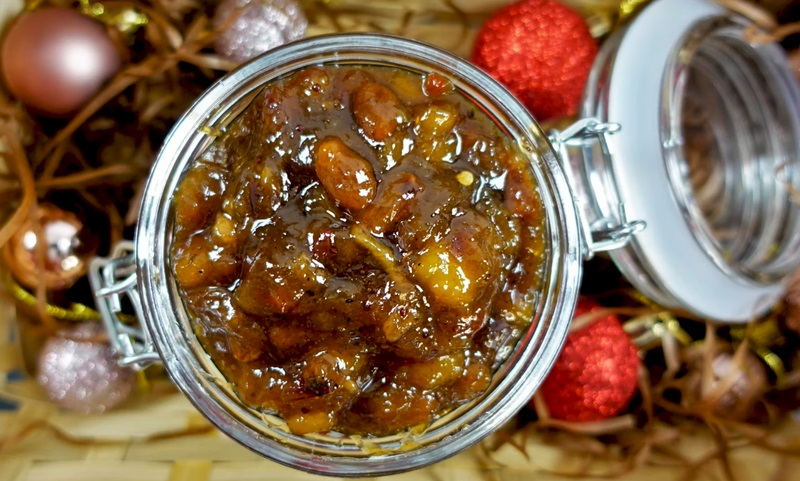
Major Grey's Chutney Dish is a delectable Indian fusion dish that beautifully blends traditional Indian flavors with a touch of Western influence. This dish takes its name from Major Grey, a British officer who is said to have enjoyed Indian cuisine during the British colonial period in India. The star of this dish is the Major Grey's chutney, a tangy and sweet condiment made from mangoes, vinegar, sugar, and a blend of spices. The chutney is generously slathered on grilled or roasted chicken, pork, or even vegetables, imparting a burst of flavor that perfectly balances the savory and sweet elements.
Country Captain
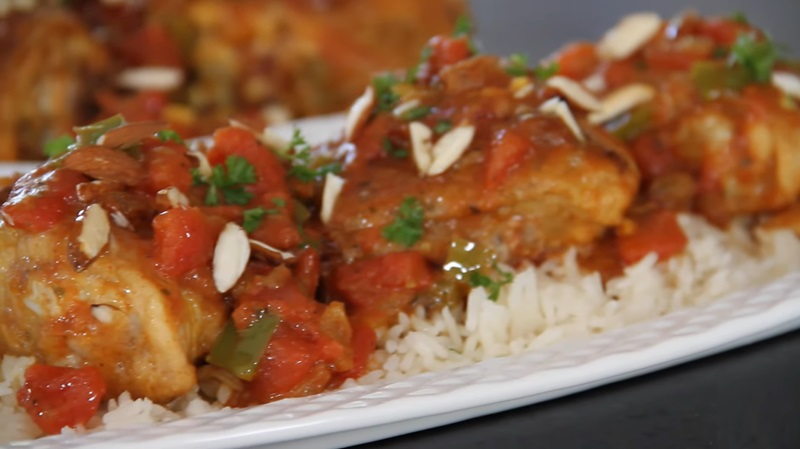
Country Captain is a dish with roots in Anglo-Indian cuisine, originating from India as a straightforward recipe for spatchcocked poultry, likely favored by British officers. This mild stew features browned chicken pieces simmered with onions and curry powder, creating a comforting and aromatic dish. It's often enhanced with the addition of almonds and golden raisins or zante currants for a hint of sweetness and texture. Variations may include tomatoes, garlic, and bell peppers, adding depth to the flavors.
Cafreal

Cafreal or Frango à Cafreal is a spicy chicken dish that has become a favorite in the Indian state of Goa. It has its roots in the Portuguese colonies in Africa and was introduced to Goan cuisine through the influence of Portuguese settlers and African soldiers. The dish is known for its unique combination of flavors, which include fresh coriander leaves, green chillies, ginger, cinnamon, onion, garlic, pepper, clove powder, chilli, mace, and vinegar or lime juice. Traditionally, chicken cafreal is made by marinating whole chicken legs in these spices and herbs, then shallow-frying them to perfection. It is commonly served with potato wedges and lime wedges, and has gained popularity in the bars and taverns of Goa.
Fish Head Curry
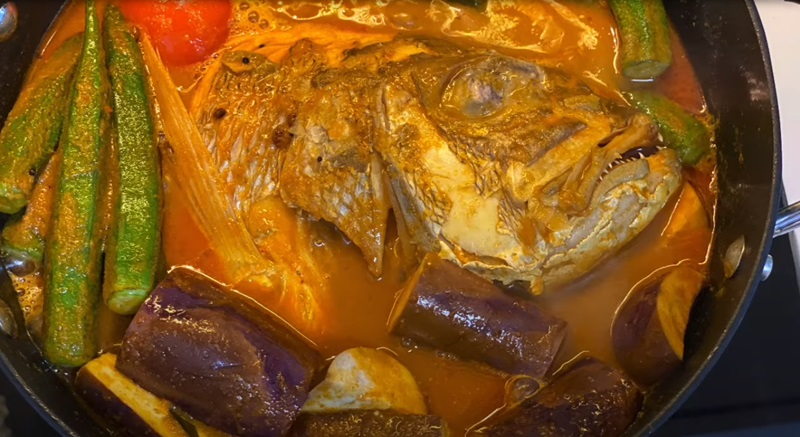
Fish head curry is a delectable and unique dish that is a result of the fusion of Indian and Chinese culinary influences. This dish, popular in Indian fusion cuisine, combines the rich and aromatic flavors of Indian spices with the tanginess of Chinese-style curry. The star of this dish is the fish head, which is simmered in a thick and flavorful curry gravy. The fish head is typically marinated in a blend of spices, including turmeric, chili powder, coriander, and cumin, before being cooked to perfection. The curry sauce is made with a harmonious blend of tomatoes, onions, garlic, ginger, and a variety of spices such as fenugreek, cinnamon, and cloves. The result is a dish that is both spicy and tangy, with the fish head adding a unique and distinctive flavor.
Goa Sausage
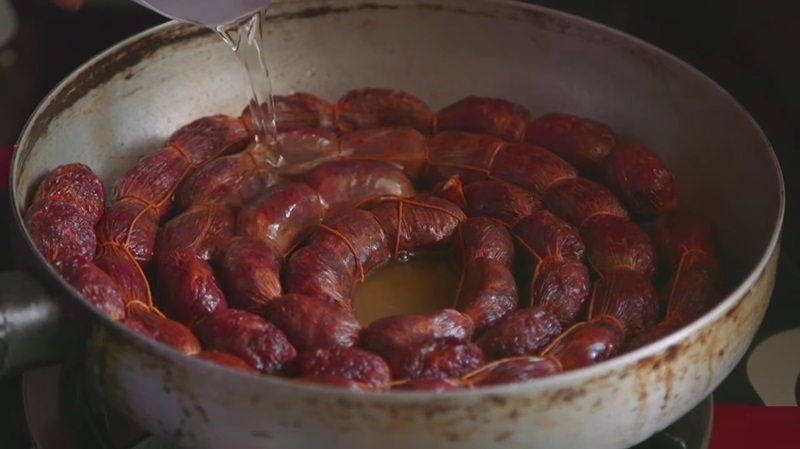
The Goa sausage, also known as Choris, is a perfect example of the blending of Indo-Portuguese culinary traditions in Goa, a region that was once under Portuguese rule in India. Derived from the Portuguese Chouriço sausage, the Goa sausage was modified to suit the local environment, which presented challenges for preserving European-style sausages due to the humid conditions. To overcome this, boneless pork is salted, sun-dried, and then pickled in a combination of vinegar, alcohol, and a chili-spice blend before being encased in pig gut.
With its roots in Iberian traditions and connections to the Spanish Chorizo, both of which undergo a process called pimenton, the Goa sausage begins with sun-dried, heavily salted pork. A delicious blend of spices, ground hot chili peppers, palm vinegar, and Feni, a local liquor, is added. The resulting sausages are either sun-dried or slowly smoked once they are filled into casings.
Typically enjoyed in curry, boiled or fried, the Goa sausage pairs well with white rice, baked potatoes, or is sometimes accompanied by a boiled egg. Another popular preparation involves boiling slices of the sausage with onions and vinegar. These sausages are traditionally made during the dry season from December to March, but are consumed more frequently during the monsoon/wet season when fish is less readily available.
Fish Moolie
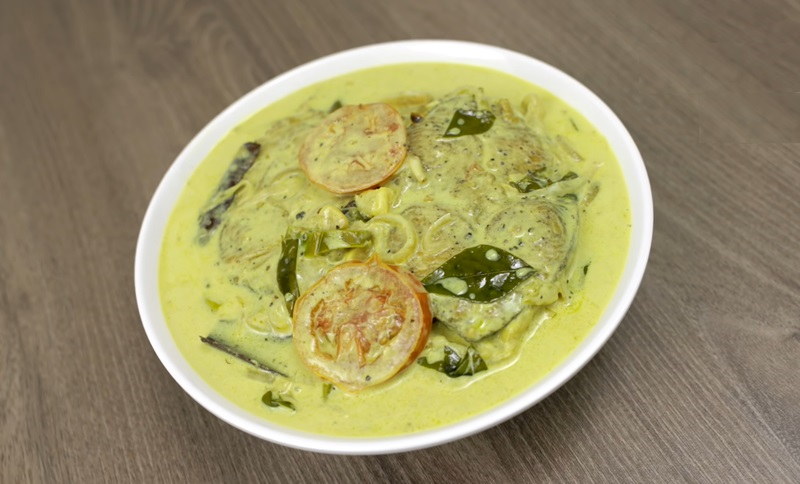
Fish Moolie is a delightful and flavorful dish that represents the fusion of Indian and European culinary traditions. This dish originates from the coastal regions of India, where fish is abundant and spices are aplenty. It is a perfect example of how Indian cuisine adapts and embraces influences from different cultures. Fish Moolie is typically made with a white fish, such as cod or tilapia, which is cooked in a creamy coconut milk-based sauce. The fish is gently simmered with a blend of aromatic spices like turmeric, cumin, coriander, and curry leaves. The use of these spices adds depth and complexity to the dish, while also infusing it with the vibrant flavors of Indian cuisine. What sets Fish Moolie apart is the addition of European ingredients like onions, garlic, and ginger, which lend a unique twist to the traditional Indian curry. The coconut milk adds a rich and creamy texture, complementing the delicate flavors of the fish beautifully.
Chinese Bhel
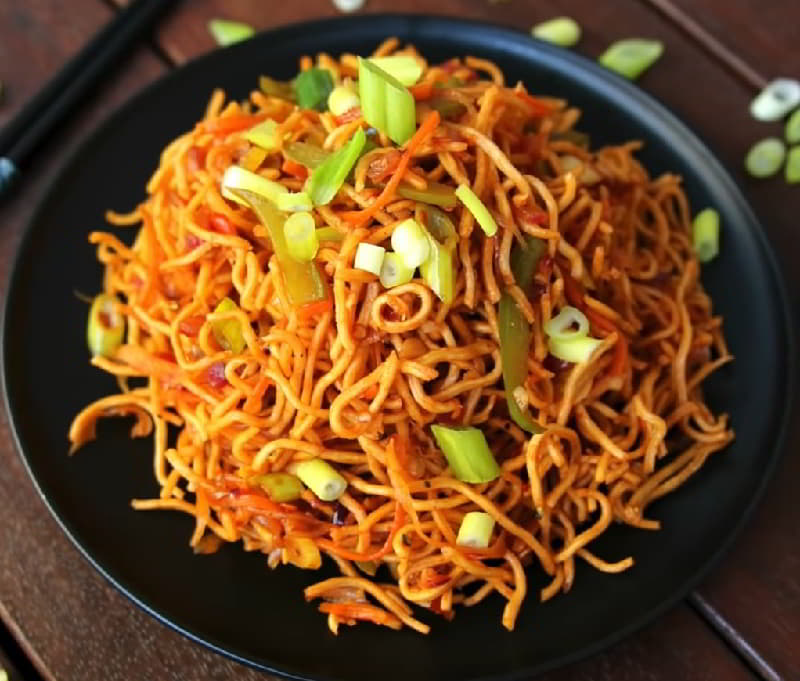
Chinese Bhel, a popular and irresistible fast food and street food delicacy in India, is a seamless fusion of Indo-Chinese flavors. This delightful dish combines the best of chop suey and bhelpuri, resulting in a truly unique culinary creation. Known for its vibrant and zesty taste, Chinese Bhel has become a highly sought-after snack, especially among the bustling streets of Mumbai. The preparation involves a delightful combination of crispy fried noodles, assorted vegetables, and a savory blend of sauces. The harmonious blend of Chinese and Indian culinary elements creates an irresistible texture and taste, making it a favorite among food enthusiasts.
Balchão
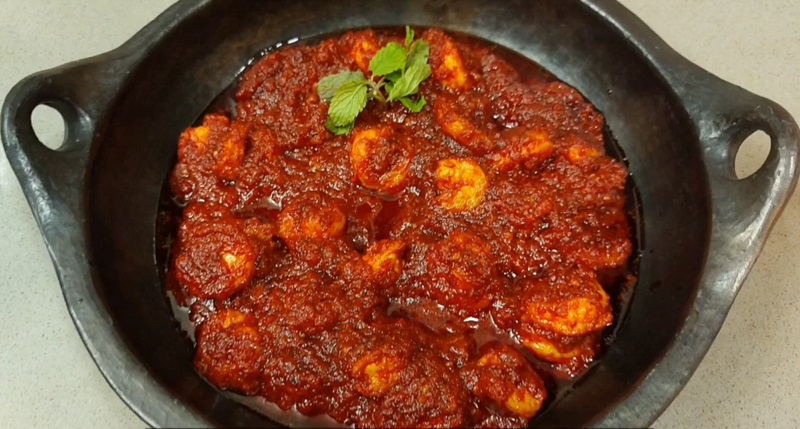
Balchão is a delightful Goan dish that combines crispy fried prawns with a tangy and flavorful sauce. This culinary treasure originated in Portuguese Goa, with influences from Malacca, and has evolved over time. The dish can be made with fish, prawns, or pork, and features a spicy tomato-chili sauce that resembles pickling techniques. One interesting variation incorporates tamarind sauce for a unique twist.
Traditional Balchão requires a paste made from dried shrimp, locally known as galmbo. The paste is made by grinding prawns, tomatoes, garlic paste, onions, ginger paste, cumin seed, dried red chilies, cinnamon, mustard seeds, cloves, sugar, salt, and vinegar. The prawns are carefully prepared and the spices are roasted before being ground into a paste with vinegar. The cooking process involves frying the prawns until they turn opaque, followed by sautéing onions and tomatoes until they become tender. The spice-vinegar paste is then added, along with sugar and salt, resulting in a delicious combination where the flavors blend harmoniously.
Crab Curry (Goan)
-1706612962.jpg)
Crab curry is a gastronomic masterpiece that originated from the regions of Goa, Daman and Diu, showcasing the Portuguese culinary heritage in India. The curry, with its vibrant yellow color, incorporates a medley of flavors such as tomato, garlic, onion, piri piri, spices, and coconut. The grated coconut adds a luxurious texture to the curry as its milk is extracted. The crab, either cut into pieces or shredded, is simmered with these ingredients, while coconut milk is introduced to enhance the flavors. Traditionally served with white rice, this dish offers a delightful blend of spices and textures, representing the fusion of Goan and Portuguese culinary influences.
Canja de Goa
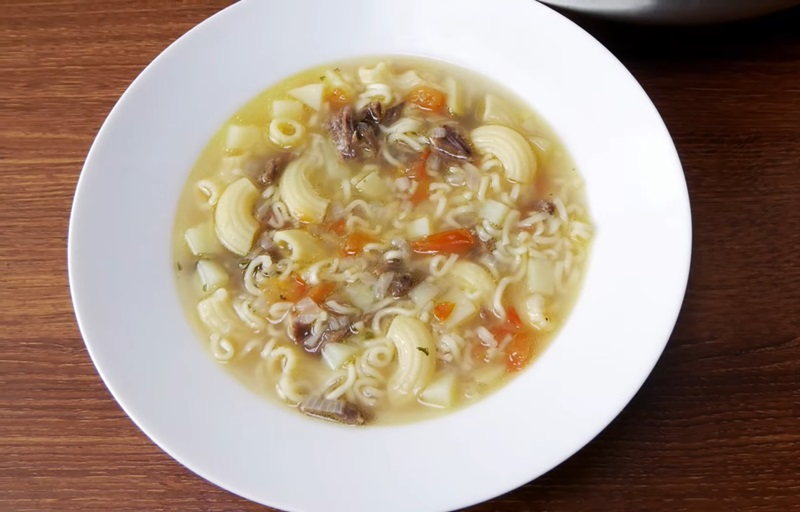
Canja de Goa, a renowned dish in Indo-Portuguese cuisine, represents the diverse culinary heritage of Goa, Daman, and Diu, regions that were once part of Portuguese India. This traditional soup combines local ingredients with Portuguese influences to create a comforting and flavorful meal. The soup harmoniously blends local sausage, onion, chicken, rice, water, garlic, and salt, simmering to perfection in a saucepan or pressure cooker. The addition of chicken bone extract adds depth and richness to the dish.
In the past, Canja de Goa held a special significance as it was often prepared with love and care for women giving birth in their homes. It symbolized nurturing and nourishment, and was accompanied by a thoughtful offering of port wine and six chickens, believed to provide strength and recovery for both new mothers and those in need of healing. Typically served around 11 am, this soup was enjoyed alongside leftover curry from the previous day, sweet mango chutney, and salted fish, creating a delightful mid-morning meal.






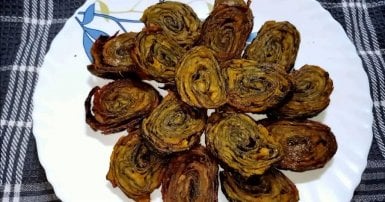
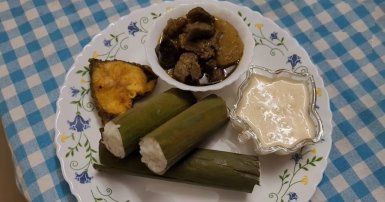

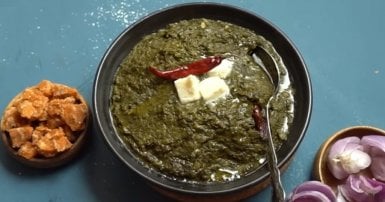
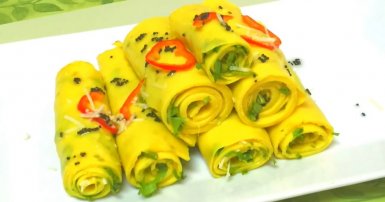
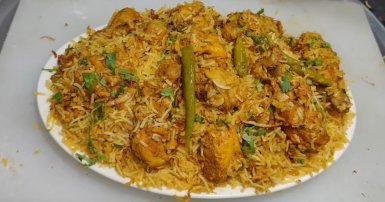

-1709813013.jpg)


